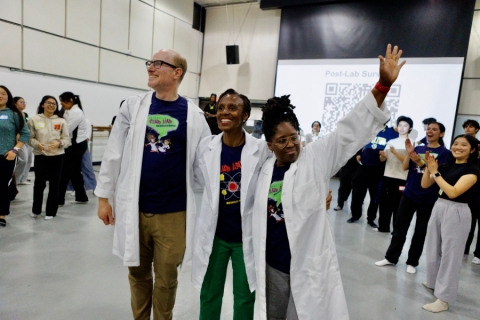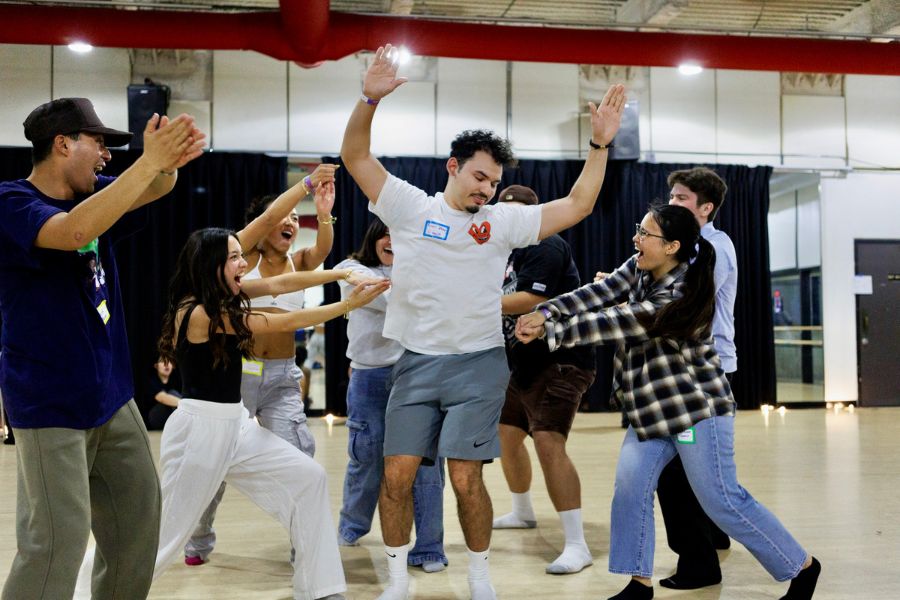Molecules in Motion: Where Dance and Chemistry Collide
UC Irvine’s innovative event showcases the synergy between artistic expression and scientific inquiry
At UC Irvine, the intersections of dance and chemistry culminated in an interdisciplinary event titled "Club Lab Freestyle: Molecules in Motion." Hosted in the Claire Trevor School of the Arts dance studios, the event represented a significant collaboration between the arts and sciences in higher education. Spearheaded by three distinguished UC Irvine professors — Dr. Gregory Weiss (Department of Chemistry), Dr. S. Ama Wray (Department of Dance) and Cyrian Reed (Department of Dance) — the lab invited students to co-create and reinterpret chemical reactions through movement. The objective was to invoke creativity, explore diverse teaching methodologies and represent molecules in a tangible form.
"My research concerns the movements of molecules, their dynamics and how they're constantly changing in their motions,” said Weiss. “I want to understand that better so I can make new molecules that cure diseases and solve problems facing our planet. I need my students to join me in this effort. As a professor, I need to inspire my students to think about molecules as dynamic entities that do cool things. Here at UC Irvine, it thrills me to tackle this problem by applying a cross-disciplinary approach combining dance and chemistry.”
Club Lab is the culmination of a two-year project developed under UC Irvine’s Chancellor’s Arts & Culture Initiative, Illuminations. This program aims to showcase the creative excellence at the university and ensure all students, regardless of their major, have meaningful exposure to the arts. For most chemistry students, this event marked their first time on the arts campus, highlighting the rarity of this interdisciplinary collaboration. By merging the classrooms of Weiss, Wray and Reed, the initiative successfully integrated chemistry and the arts. This unique approach enabled students to achieve a creative state through movement, developing new ways of understanding organic chemistry.
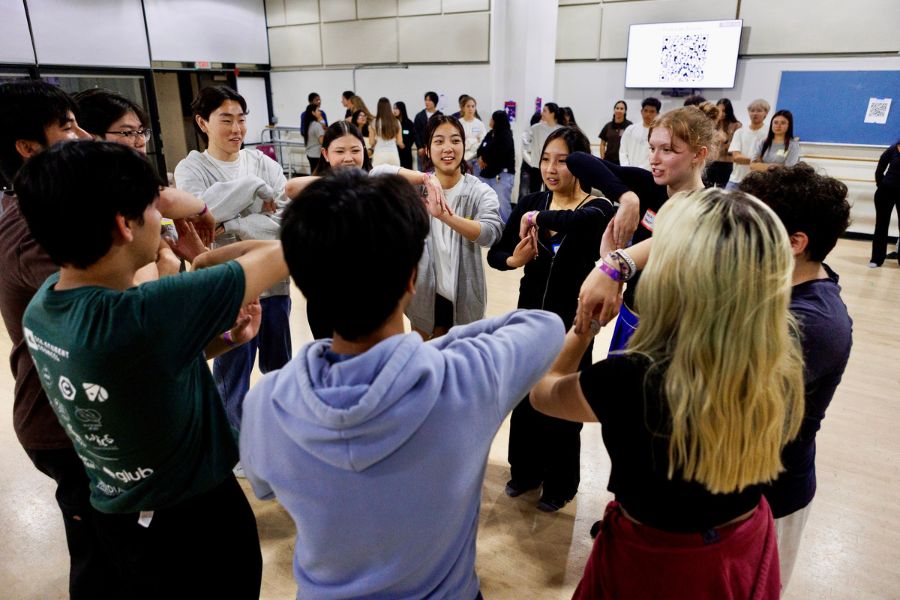
Image: Undergrad students from Organic Chemistry (Chem 51C) and dance together demonstrating chemical reactions. Photo by Dan Hopkinson.
“Movement is at the center of all things — it is not peripheral,” shared Wray. “Everything in the universe is in motion and our students were able to experience this concretely, and to widely access chemistry concepts through the creative animation of their bodies alongside others.”
Dance studios were transformed into vibrant dance-chemistry labs, bringing together dancers, musicians and chemists. At the start of the dance warm-ups, students were rigid and subdued. Some participants were eager, while others, unfamiliar with the style of teaching, were initially hesitant to express different molecules through movement.
However, as the evening progressed, a palpable shift occurred. Students who had never been in a dance class before not only became more confident in their creative expression, but also gained assurance in the source material. Professor Weiss noted that many of his students, who had never spoken up in class before, were now proudly identifying SN1 and SN2 reactions in front of their peers. The rooms were filled with laughter, communication with unfamiliar faces and a renewed desire for deeper learning.
The program featured two distinct labs, each offering a convergence of dance and chemistry. When students first stepped into the hip-hop lab, they were greeted by a DJ with turntables, blasting Kendrick Lamar's latest hit, "Not Like Us." This dynamic entrance transformed the traditional academic space into an energizing environment, unexpected for a weekday course at a leading R1 research institution. Groups of students, guided by Club Lab leads, all of whom were double majors in dance and science, engaged with chemical concepts, discussing and interpreting molecules and compounds through choreographed movements. Each group presented a routine to articulate their assigned chemical reaction or molecule, turning abstract concepts into kinetic art. The vibrant atmosphere, underscored by the DJ’s music, encouraged students to stay longer, dance battle, and discuss the impact of their performances with Professors Reed and Weiss.
“I believe there is art in everything that we do,” shared Reed. “Dance is a connecting component to theories, ideas, and philosophies. The fact that we're able to bridge the two together and that the students can view material in a different light is unconventional and inspiring. Nobody learns the same. I feel we can do this to help cultivate the students’ learning processes.”
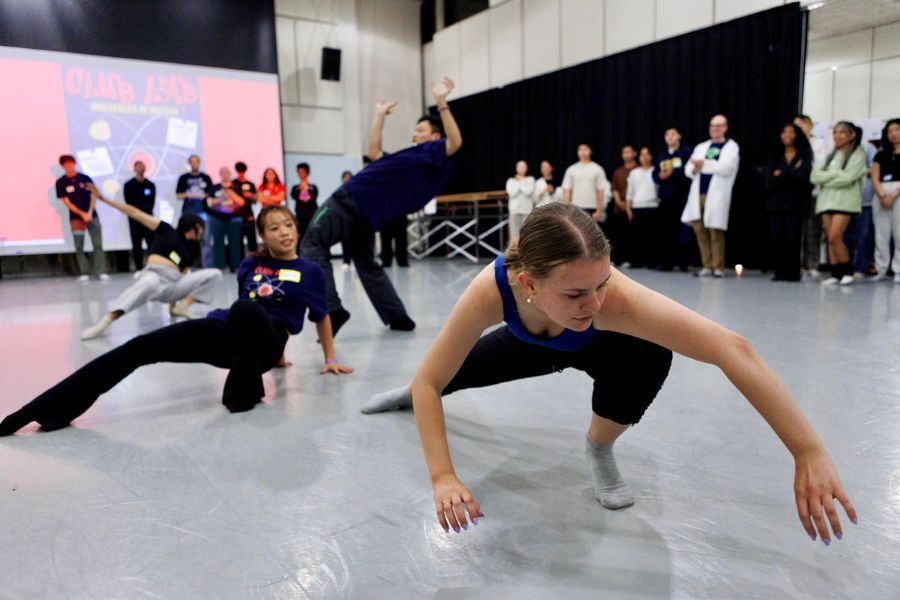
Image: Dance students demonstrating chemical reactions. Photo by Dan Hopkinson.
In the jazz lab, participants were transported to a setting reminiscent of a live jazz club, complete with students from the music department playing the trombone, keys, bass and drums. Here, the intersection of jazz and chemistry took on a multisensory approach. Under the guidance of Wray, students were encouraged to move in rhythm with the music and collaborate not just with each other, but with specific instruments. For instance, when a group was tasked with depicting an SN1 reaction, a student embodying the stabilizing molecule responded to the shifts in the trombone's melody. As the trombone signaled a change, the lead molecule would pull apart, allowing the rest of the group to represent the ensuing chaos of the reaction. This immersive and interactive approach fostered a deeper understanding of chemical processes through the language of movement and music, making complex scientific concepts accessible and engaging.
“The molecules themselves are always in motion, and their behaviors are influenced by the context in which they form bonds with other substances," shared Wray. "Each molecule has physical attributes, and embodying these ideas allows us to bring what is already happening into an actualized state. We are not asking the students to do something that's not already occurring; it's about animating these processes through their bodies, taking what happens on a sub-nano level and making it explicit.”
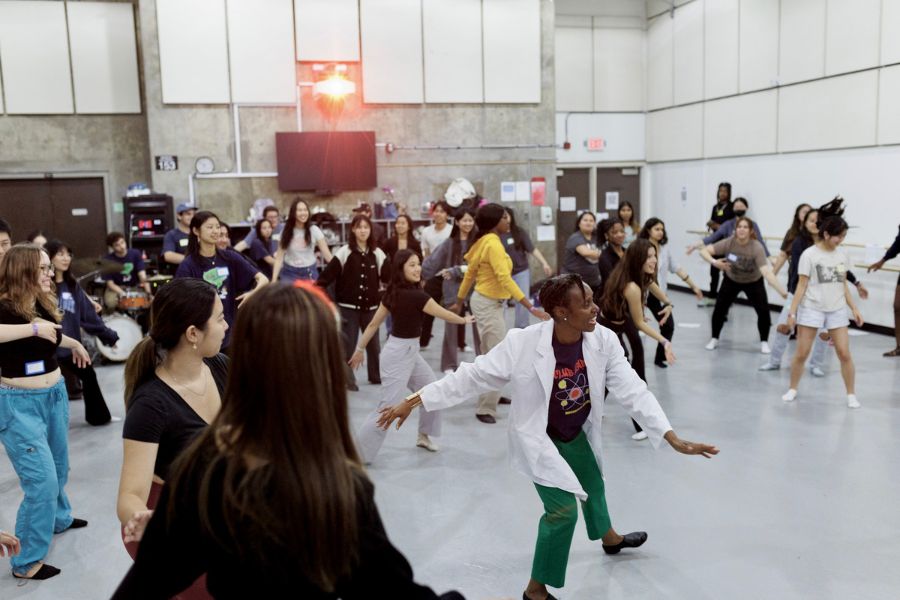
Image: Students warming up in Professor Wray's jazz lab. Photo by Dan Hopkinson.
This freestyle approach embraced improvisation as a pedagogical tool, leveraging the popularity of these musical genres to make the learning process more accessible and engaging. Students worked beyond conventional frameworks and used creativity to learn chemistry.
“Creativity and inventing things are incredibly fun," shared Weiss. "This is a universal language that everyone can speak. Jazz dance and hip-hop are expressions everyone can connect with, and they provide the opportunity to invent something new. It brings a sense of excitement and reminds us of all the joys of learning. CTSA excels at restoring curiosity in learning environments, and that has been thrilling to experience.”
This lab not only demonstrated the potential for interdisciplinary collaboration but also set a precedent for future educational innovations.
"Learning is a multimodal experience where you can access different parts of your brain and body,” shared Katie Waldvogel, a double major graduating in dance and molecular biology and biochemistry. “Club Lab offers a unique opportunity to merge chemistry and movement-based learning, broadening students' experiences and learning styles."
The success of "Club Lab Freestyle: Molecules in Motion" highlights the importance of integrating diverse fields to enrich the learning experience, setting the standards for a more inclusive and creative approach to education at UC Irvine.
Image: Undergrad students from Organic Chemistry (Chem 51C) and dance presenting their choreographed chemical movements to wider group. Photo by Dan Hopkinson.
Professors Weiss, Wray and Reed extend their gratitude to the individuals who made Club Lab Freestyle possible. Special thanks to double majors in dance and chemistry or molecular biology and biochemistry: Lauren Lim, Sarah Sun and Katie Waldvogel. Additionally, dance alumni Bela DePalatis and Paloma Perez-Rojas provided essential design contributions. The event was enriched by musicians Collin Felter (Trombone), Maddox Eckert (Drums), Adam Kormondy (Keys), Matt Ward (Bass) and DJ ACE.

